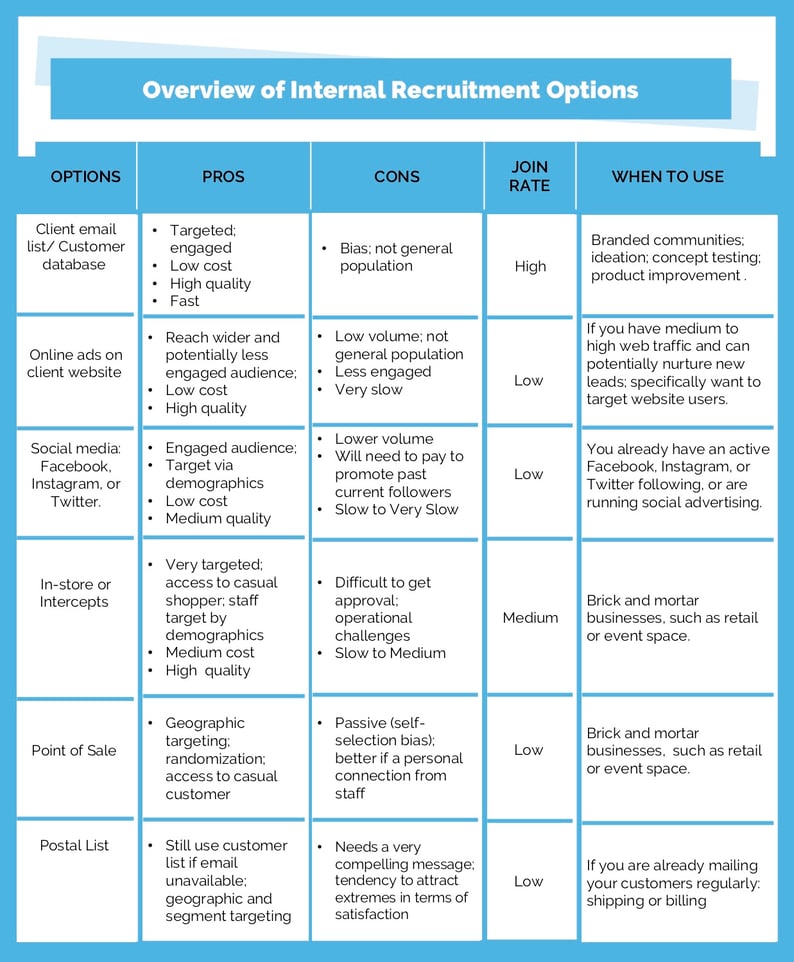Before you launch your community you’ll need to build a list of potential members to invite. You’ll most likely be tapping into a database of existing customer contacts, but in some cases you’ll want to recruit from an external source. Here’s a guide that will help you determine if you should use internal or external recruiting, and how to navigate each type of the recruitment to get the best engagement and avoid potential pitfalls.

Overview of Internal and External Options
Internal Sources
Most organizations recruit their communities from internal sources, which include: internal databases, loyalty programs, company and brand websites, social media, and sometimes even direct mail and in store activity.
Members recruited from internal sources tend to have higher brand affinity and engagement than people recruited from external sources. Internal recruit sources tend to have higher response rates and don’t turnover as often.

External Sources
Once internal and free sources have been exhausted, it’s time to think about external recruitment options. The key to success with this type of recruitment is to focus on a “pull” rather than “push” method. A push method refers to initiating contact with the lead first, such as cold calling or emailing a purchased list. A “pull” recruitment method refers to a strategy where a new member contacts you first via an enticing offer for them to join the community, this usually happens via a contact form or a by clicking on a link.
Members recruited from external sources often have higher expectations for getting paid to participate. They typically have lower engagement, and their response rates are sometimes only half that of members recruited from internal sources. The turnover is higher in this type of community and you’ll need to recruit more often.
A note on anti-spam: most regions have strict anti-spam laws that prevent companies from reaching out to cold leads (purchased list), whether they are B2B or B2C, without having their prior consent. That’s why using a “pull” strategy is a safer bet.
What Unique Resources Can You Leverage?
When recruiting a community, determine what special circumstances apply to your brand. For example, some of our telecommunication clients use SMS to recruit members. Since they are a telco, they have their customers’ mobile phone numbers, and thus, typically, have the right to use them.
CBS in the UK has used its own advertising assets to promote its Work.Shop.Play community, particularly on London transport. It has also worked with magazines to utilize the magazine’s mailing list or advertising space in return for running projects on their community. Broadcast media have a wide range of options to attract members to their community.
The key questions for any brand or organization is to ask, “What is special about our situation and how can we utilize it?” This might mean ‘special’ in terms of the people the organization is trying to recruit, or it might mean ‘special’ in terms of potential recruitment partners.
Determining Email List Quality
Recruiting from email lists is the most common way to quickly build up insight community membership. However, the join rates will depend on the quality of the list. The following factors will all have an impact on how effective a list is in supplying members.
How old is the customer email list? When were the email addresses collected? Lists generated in the past few months are the most effective.
How was the list generated? If it’s a ‘sign-up to win’ list, for example, from the client’s website or from other promotions and coupon lists, then it will likely not be a very engaged list.
How often is the list used for communications? If the recipients are getting multiple emails a month for various marketing reasons, then the list will likely not produce as high a join rate, given that people may be fatigued from receiving emails. By contrast, if the list is rarely used, it can be a collection of disengaged people, which can also lead to a low response.
What are the typical campaign results for a mail-out to this list? This will give a good indication of how good your recruitment is likely to be. Key things to note are the open and click rates for different types of messages and campaigns.
Do the messaging and rewards match the target audience? The right tone of voice, length of content, benefits of joining, and rewards for joining messages and style will vary depending on who the target audience is. What works for B2B may not work for young men or mothers with young kids.
Be prepared to execute a ‘Plan B’ if the list quality does not look like it will yield enough members to build out the community to the desired size.
Launching the Recruitment Exercise
Always do a soft launch of the list (approximately 10% of the planned mailing) to see how the list is performing, and also to test drive the Recruitment Survey (checking stop points, skip patterns, quotas, etc.).
Calculate the join rate from the soft launch and assume the same results from the rest of the list. Brainstorm a ‘Plan B’ if it looks like the list may not yield enough members. In particular, focus on other possible internal recruitment options.
As people join the community, check the community composition to see if you need to target certain demographics or types of member.
If the results are less than what you expected based on other email campaigns, review the recruit invitation, into to the recruitment survey and the survey itself, and the new member welcome experience to see if anything can be improved upon.








